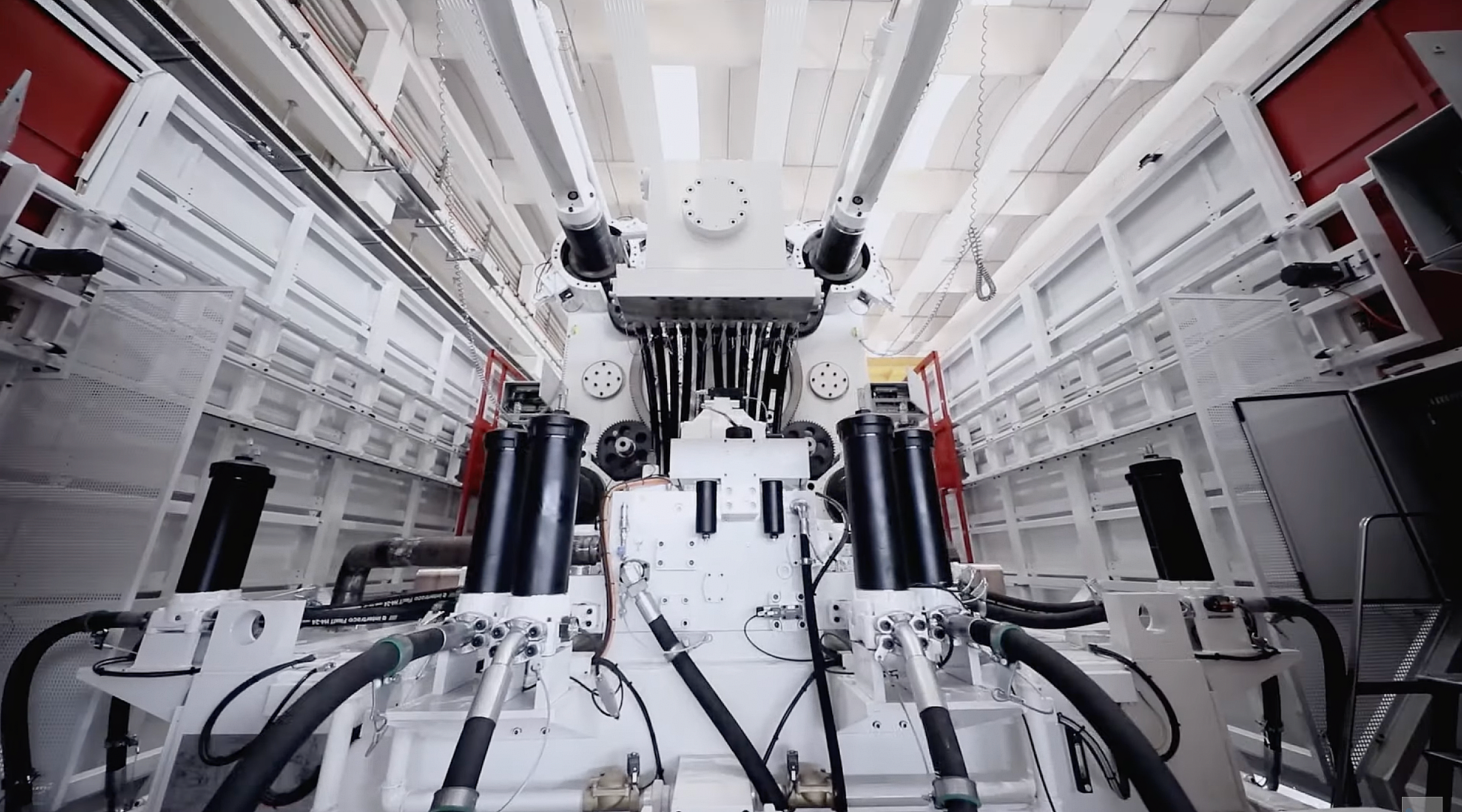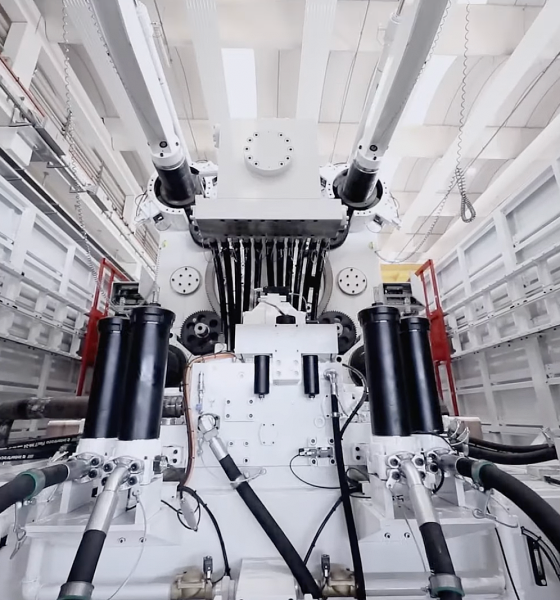

News
Tesla’s partner IDRA shares insights on the Cybertruck Giga Press’ potential
Tesla’s next generation of vehicles will be built on the back of the Giga Press, a machine capable of producing massive, single-piece casts for critical components like an electric car’s rear underbody. In a recent video, IDRA, the company building the house-sized die-casting contraptions, shared some insights on the daunting machine’s development, its advantages, and its upcoming iterations like the 8,000-ton Giga Press that will be used for the Tesla Cybertruck.
In a recently posted video, IDRA General Manager Riccardo Ferrario explained that the Giga Press is specifically designed to be as environmentally-conscious as possible. Developed over several years, the Giga Press could provide automakers with a number of key advantages, such as less investments, less handling of parts, better quality, less energy consumption, and lower CO2 emissions. Consequently, these are things that are incredibly important to a company like Tesla, which has established itself as the frontrunner in the sustainable transportation movement.
#GigaBerlin #Gigapress
An important statement from the IDRA 🇮🇹 Group General Manager.
" what is GIGAPRESS and wich are GIGAPRESS innovative goals"
2 of them are already built on the GIGABERLIN.https://t.co/IWtPOzuQhT pic.twitter.com/pscXGmqm27— Gigafactory Berlin News (@Gf4Tesla) April 1, 2021
Much like Tesla’s electric car lineup, the Giga Press family is only getting started. As explained by the executive, IDRA is still looking to expand the Giga Press family, and recently, the company was able to do just that. Just last month, Ferrario remarked that IDRA received the first order for its largest machine yet—an 8,000-ton Giga Press specifically designed to produce parts for larger vehicles like pickup trucks and SUVs.
The IDRA executive did not name its customer for the order, though all signs are pointing to Tesla, a company that has already purchased numerous 6,000-ton Giga Presses from the Italian company. Tesla CEO Elon Musk has also mentioned that the Cybertruck’s rear underbody would be produced by an 8,000-ton die-casting machine, which is significantly larger than the Giga Presses used for the Model Y.
“We have increased our range of machines to encompass also another world first—an 8,000-ton die-casting press. And it is with great pride that I can announce, we have done it. It’s no longer just a dream or drawings on paper. It’s now reality. A reality that IDRA and the team behind the Giga Press have been able to execute in a very short space of time following the very high demand of our customer from all around the world.
“The first-ever order for an 8,000-ton machine has now been received in March 2021. We are so excited about taking the idea of the Giga Press a step further and applying it directly to the SUV and truck market, which is an area, until now, not fully explored. Full electric trucks for transportation of goods used by companies such as DHL or Amazon can enlarge the market of Giga Press,” the IDRA General Manager said.
Tesla is currently putting the pedal to the metal on the construction of Gigafactory Texas, where the Cybertruck would be produced. As such, IDRA would have to put in a lot of effort to ensure that it can deliver its largest machine to date on time. If the executive’s message is any indication, however, it appears that IDRA is just as excited to push the limits of the die-casting industry just as much as Tesla is eager to push the limits of electric cars. This suggests that the 8,000-ton Cybertruck Giga Press might make it to Giga Texas at just the right time for the start of the all-electric pickup truck’s production.
Watch IDRA’s latest video on its Giga Press machines in the video below.
Don’t hesitate to contact us for news tips. Just send a message to tips@teslarati.com to give us a heads up.

News
Tesla FSD fleet is nearing 7 billion total miles, including 2.5 billion city miles
As can be seen on Tesla’s official FSD webpage, vehicles equipped with the system have now navigated over 6.99 billion miles.

Tesla’s Full Self-Driving (Supervised) fleet is closing in on almost 7 billion total miles driven, as per data posted by the company on its official FSD webpage.
These figures hint at the massive scale of data fueling Tesla’s rapid FSD improvements, which have been quite notable as of late.
FSD mileage milestones
As can be seen on Tesla’s official FSD webpage, vehicles equipped with the system have now navigated over 6.99 billion miles. Tesla owner and avid FSD tester Whole Mars Catalog also shared a screenshot indicating that from the nearly 7 billion miles traveled by the FSD fleet, more than 2.5 billion miles were driven inside cities.
City miles are particularly valuable for complex urban scenarios like unprotected turns, pedestrian interactions, and traffic lights. This is also the difference-maker for FSD, as only complex solutions, such as Waymo’s self-driving taxis, operate similarly on inner-city streets. And even then, incidents such as the San Francisco blackouts have proven challenging for sensor-rich vehicles like Waymos.
Tesla’s data edge
Tesla has a number of advantages in the autonomous vehicle sector, one of which is the size of its fleet and the number of vehicles training FSD on real-world roads. Tesla’s nearly 7 billion FSD miles then allow the company to roll out updates that make its vehicles behave like they are being driven by experienced drivers, even if they are operating on their own.
So notable are Tesla’s improvements to FSD that NVIDIA Director of Robotics Jim Fan, after experiencing FSD v14, noted that the system is the first AI that passes what he described as a “Physical Turing Test.”
“Despite knowing exactly how robot learning works, I still find it magical watching the steering wheel turn by itself. First it feels surreal, next it becomes routine. Then, like the smartphone, taking it away actively hurts. This is how humanity gets rewired and glued to god-like technologies,” Fan wrote in a post on X.
News
Tesla starts showing how FSD will change lives in Europe
Local officials tested the system on narrow country roads and were impressed by FSD’s smooth, human-like driving, with some calling the service a game-changer for everyday life in areas that are far from urban centers.

Tesla has launched Europe’s first public shuttle service using Full Self-Driving (Supervised) in the rural Eifelkreis Bitburg-Prüm region of Germany, demonstrating how the technology can restore independence and mobility for people who struggle with limited transport options.
Local officials tested the system on narrow country roads and were impressed by FSD’s smooth, human-like driving, with some calling the service a game-changer for everyday life in areas that are far from urban centers.
Officials see real impact on rural residents
Arzfeld Mayor Johannes Kuhl and District Administrator Andreas Kruppert personally tested the Tesla shuttle service. This allowed them to see just how well FSD navigated winding lanes and rural roads confidently. Kruppert said, “Autonomous driving sounds like science fiction to many, but we simply see here that it works totally well in rural regions too.” Kuhl, for his part, also noted that FSD “feels like a very experienced driver.”
The pilot complements the area’s “Citizen Bus” program, which provides on-demand rides for elderly residents who can no longer drive themselves. Tesla Europe shared a video of a demonstration of the service, highlighting how FSD gives people their freedom back, even in places where public transport is not as prevalent.
What the Ministry for Economic Affairs and Transport says
Rhineland-Palatinate’s Minister Daniela Schmitt supported the project, praising the collaboration that made this “first of its kind in Europe” possible. As per the ministry, the rural rollout for the service shows FSD’s potential beyond major cities, and it delivers tangible benefits like grocery runs, doctor visits, and social connections for isolated residents.
“Reliable and flexible mobility is especially vital in rural areas. With the launch of a shuttle service using self-driving vehicles (FSD supervised) by Tesla in the Eifelkreis Bitburg-Prüm, an innovative pilot project is now getting underway that complements local community bus services. It is the first project of its kind in Europe.
“The result is a real gain for rural mobility: greater accessibility, more flexibility and tangible benefits for everyday life. A strong signal for innovation, cooperation and future-oriented mobility beyond urban centers,” the ministry wrote in a LinkedIn post.
News
Tesla China quietly posts Robotaxi-related job listing
Tesla China is currently seeking a Low Voltage Electrical Engineer to work on circuit board design for the company’s autonomous vehicles.

Tesla has posted a new job listing in Shanghai explicitly tied to its Robotaxi program, fueling speculation that the company is preparing to launch its dedicated autonomous ride-hailing service in China.
As noted in the listing, Tesla China is currently seeking a Low Voltage Electrical Engineer to work on circuit board design for the company’s autonomous vehicles.
Robotaxi-specific role
The listing, which was shared on social media platform X by industry watcher @tslaming, suggested that Tesla China is looking to fill the role urgently. The job listing itself specifically mentions that the person hired for the role will be working on the Low Voltage Hardware team, which would design the circuit boards that would serve as the nervous system of the Robotaxi.
Key tasks for the role, as indicated in the job listing, include collaboration with PCB layout, firmware, mechanical, program management, and validation teams, among other responsibilities. The role is based in Shanghai.
China Robotaxi launch
China represents a massive potential market for robotaxis, with its dense urban centers and supportive policies in select cities. Tesla has limited permission to roll out FSD in the country, though despite this, its vehicles have been hailed as among the best in the market when it comes to autonomous features. So far, at least, it appears that China supports Tesla’s FSD and Robotaxi rollout.
This was hinted at in November, when Tesla brought the Cybercab to the 8th China International Import Expo (CIIE) in Shanghai, marking the first time that the autonomous two-seater was brought to the Asia-Pacific region. The vehicle, despite not having a release date in China, received a significant amount of interest among the event’s attendees.








